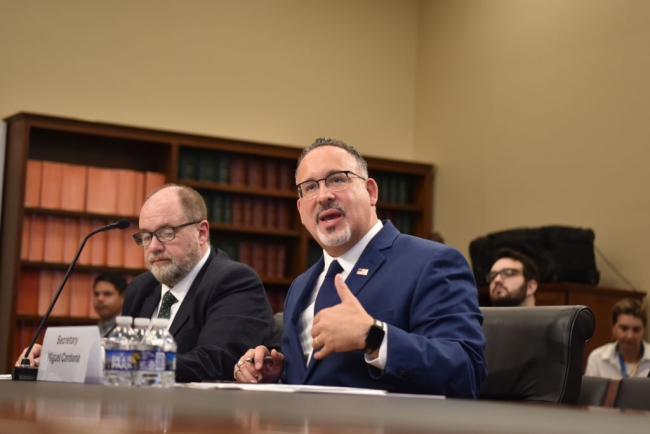You have /5 articles left.
Sign up for a free account or log in.

Education Secretary Miguel Cardona testifies at a House Appropriations Committee hearing last week.
Sha Hanting/China News Service/VCG via Getty Images
The Education Department has begun reprocessing some student aid forms affected by calculation errors, under secretary of education James Kvaal said in a press call Thursday. The department has also started sending corrected versions to colleges, but Kvaal said others could take weeks longer to begin reprocessing.
In the past few weeks, FAFSA processing has been beset by two major discoveries: student aid index calculation errors, which affected about 200,000 forms, and incorrect tax data provided by the IRS on about 330,000 forms. Combined, the errors meant nearly 20 percent of submitted FAFSAs would have to be reprocessed.
The department will reprocess all the affected forms, and has made headway on the first batch. But reprocessing those affected by tax errors is more complicated, a spokesperson said, and requires technical alterations to their systems. It is “on track” to begin reprocessing those forms by May 1—many colleges’ deposit deadlines for admitted students.
“It is a significant change in terms of the logic of our system, which did not anticipate going back and retrieving tax information a second time,” the spokesperson said. “We are in the advanced stages of code development for that solution and expect to begin testing it next week.”
In the meantime, the department is encouraging institutions to begin sending aid forms to students using the information they have—including from incorrect forms that resulted in overestimations of student aid, about two-thirds of those affected by the tax errors.
In most cases, the difference in student aid awards on the incorrect forms versus the reprocessed ones should be a few hundred dollars.
In the call, Kvaal said forms marred by student or contributor errors—about 16 percent of all submitted FAFSAs, a much higher rate than most years—are steadily being corrected, and that students can and should log back into the system to fix them as soon as possible. Two-thirds of those rejected forms are simply missing consent to retrieve tax data, a mistake Kvall said should only take minutes to correct.
“This is a challenging year, and we’re not at a point we want to be at,” he said. “We know how important this is, and how hard these delays have been for students and families.”
This past week was the department’s “FAFSA Week of Action,” meant to marshal high school counselors, college-access nonprofits and state government officials to boost FAFSA submissions, which are down nearly 30 percent from last year, according to data from the National College Attainment Network. As of Thursday, the department had received nearly 7.7 million forms, the spokesperson said.
“If you’ve been waiting for the dust to settle before filling out a FAFSA or making corrections, the time to do so is now,” Kvaal said. “If you are a student waiting for your colleges to send an offer, please know you’re not alone.”









